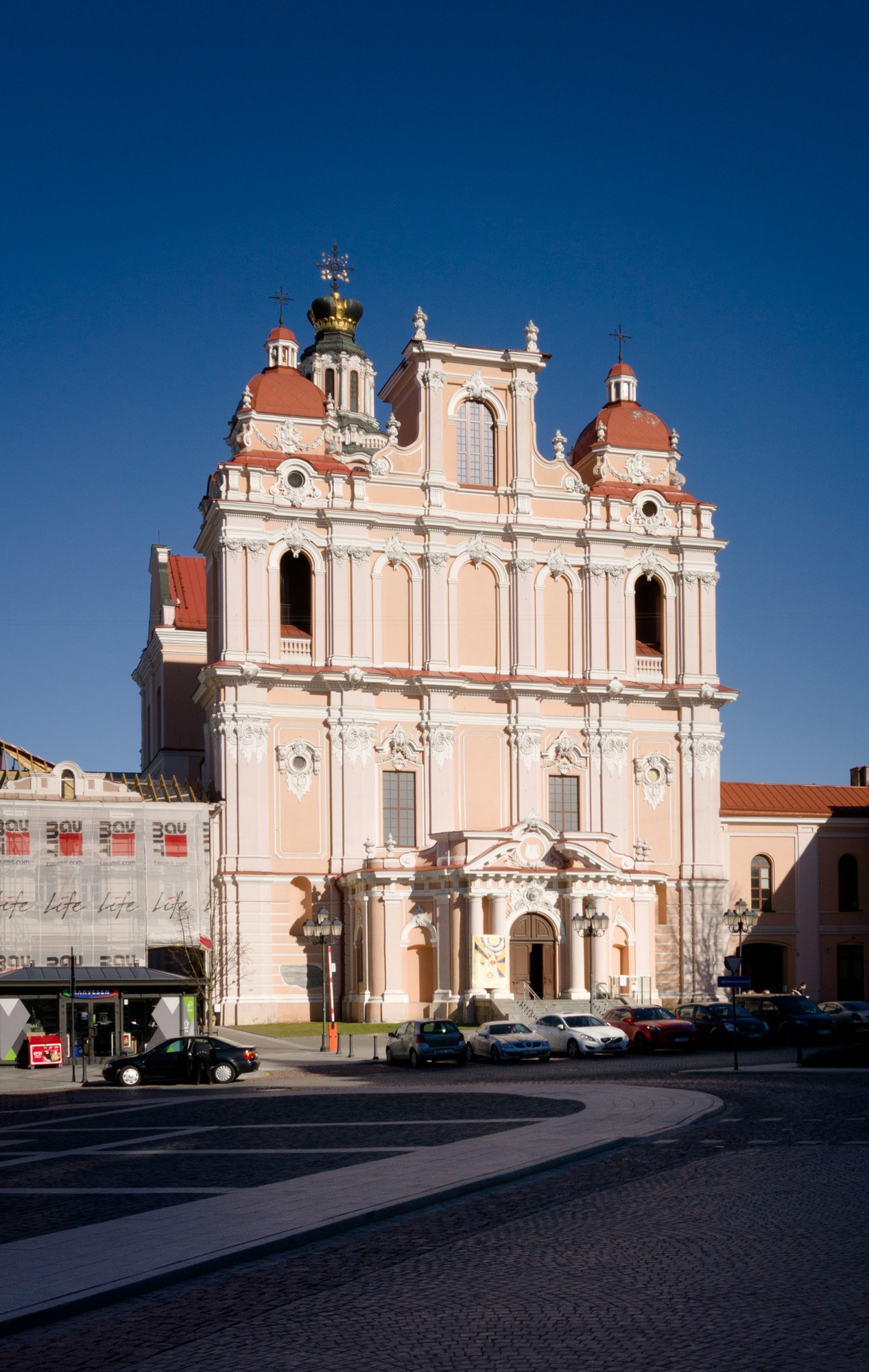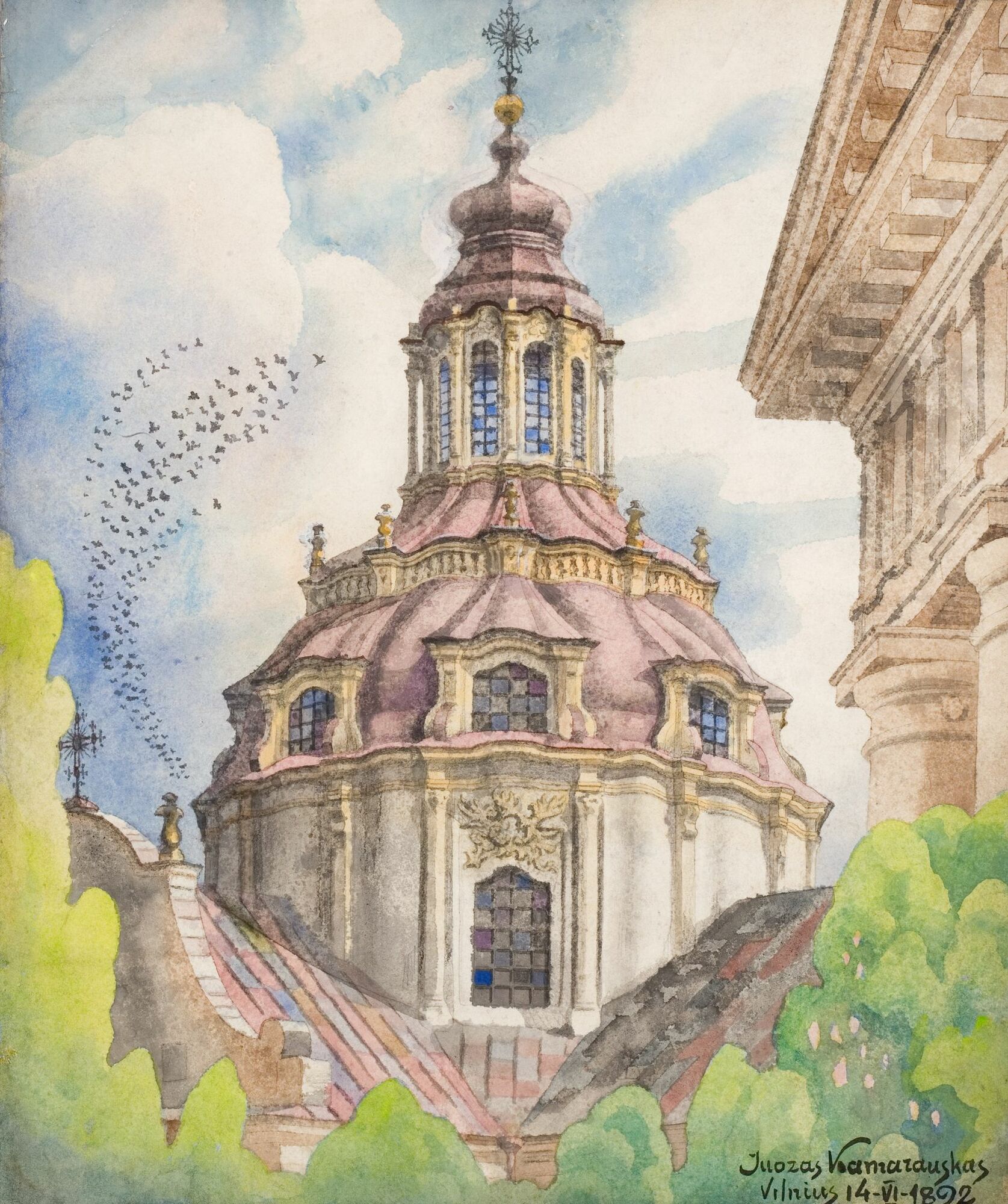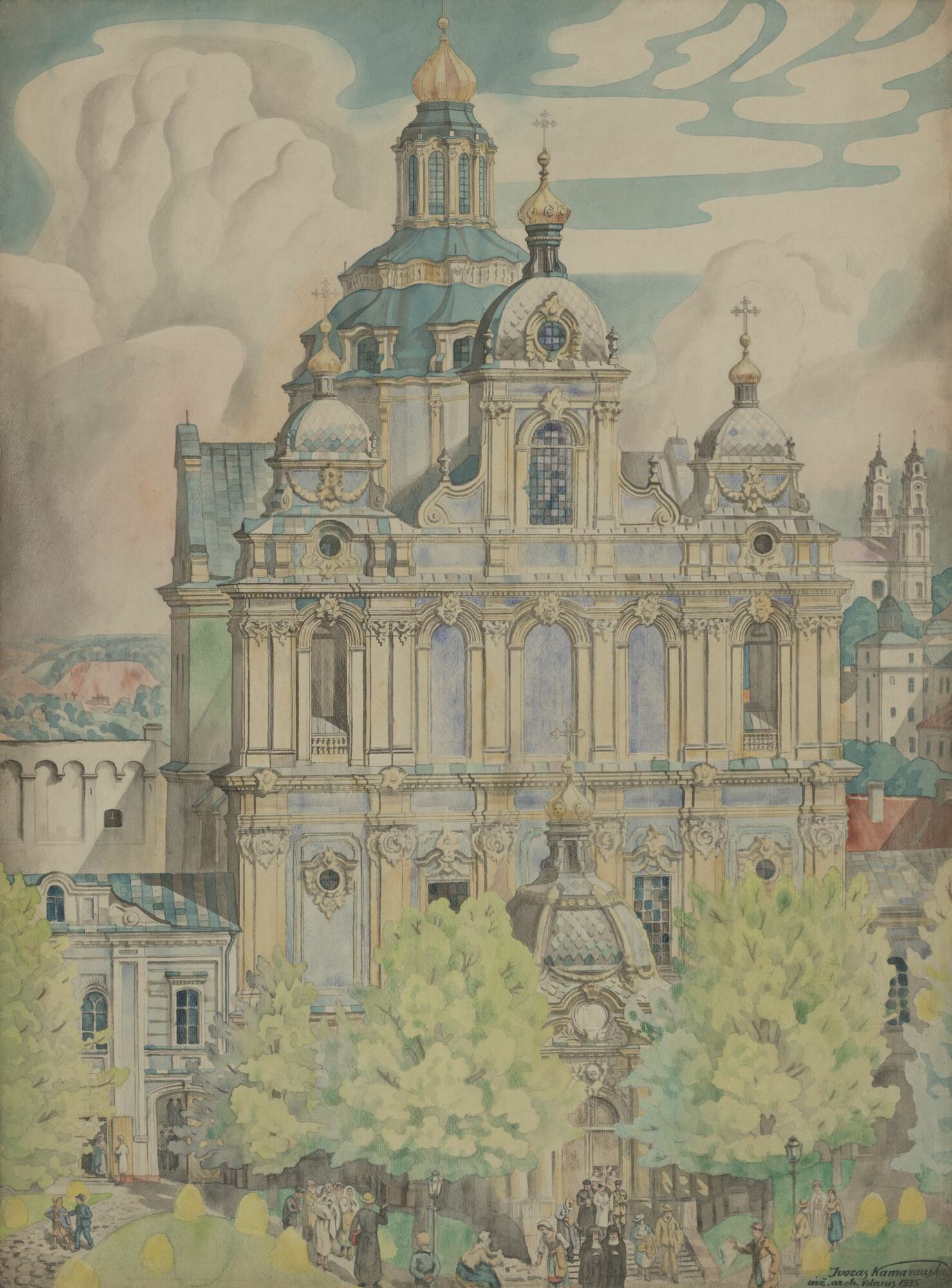CHURCH OF ST. CASIMIR

34 Didžioji Street. 2019
Photographer Tomas Kapočius
Lithuanian Art Museum
Forming an ensemble with the adjacent Jesuit monastery, the Church of St. Casimir is the first Baroque church in Vilnius. It dominates the Old Town panorama with its tall cupola decorated with a crown of the Grand Duke of Lithuania (the original was built in the 18th century, did not survive, restored in 1942). The construction works began in 1604, the interior was finished in 1618. The monastery buildings were built next to it. The church was reconstructed after a fire in 1749 (architect Thomas Zebrowski) and equipped with an elaborate late-Baroque altar. In 1812, the French army set up a grain warehouse in the church, destroying the altar as a result. The rundown church was given to missionary priests. In 1841 it was given to the Orthodox Church. In 1864–1868 it was converted into the Orthodox Church of St. Nikolaus, based on Nikolai Chagin design. The towers were lowered, the pediment replaced by a central tower, the cupola with the towers covered with onion-shaped helmets. Interior frescoes were destroyed, sculptures removed. In 1915, a Lutheran prayer house was established in the church by the German troops. In 1917, the building was returned to Jesuits. During the 1925 restoration, some of the elements that pre-existed the Chagin reconstruction were rebuilt. The church was closed in 1949, turned into a warehouse, the interior was wrecked. In 1965–1966, it was restored and converted into an Atheism Museum. In 1988, it was given back to the religious community. An early-17th century crypt with preserved frescoes was discovered beneath the great altar in 1991. It contains the remains of prominent Jesuits and a relic of St. Andrew Bobola, a martyr priest who worked in the church in the past. In 1997, Tinkerbells for St. Casimir, a sound installation by Vladimiras Tarasovas, was put up in the church towers, making music sounds when the wind blows.

Juozapas Kamarauskas (1874–1946)
Church of St. Casimir. 1892
Paper, watercolour
Lithuanian Art Museum

Juozapas Kamarauskas (1874–1946)
Church of St. Casimir in Vilnius. 1935
Paper, watercolour
Lithuanian Art Museum
PROFESSED HOUSE OF VILNIUS JESUIT MONASTERY
One of the most important buildings of the Jesuit monastery complex is the collegium, or professed house, a residence for senior monks and a temporary stay for noble laypeople. It was built next to St. Casimir Church in 1615. Some of its original architectural elements, including a tall bulky Rennaisance-style attic, have survived to the present day. Many prominent members of the Society of Jesus have lived in the professed house, including priest martyr St. Andrew Bobola, author and lexicographer Konstantinas Sirvydas, theologian, philosopher, musicologist Žygimantas Liauksminas, and historian Albertas Kojelavičius-Vijūkas. At one point in time it was also a library, an archive of the Lithuanian province of the Society of Jesus and a hospital. After the suppression of the Society in 1773, the building was used as a shelter and hospital for priests emeritus. In 1798 the building was converted into barracks, while some of the premises were inhabited by clergymen servicing St. Casimir’s Church. In 1812, the building was seized by French soldiers, who vandalised it. After the Church of St. Casimir was turned into an Orthodox one, the house was renovated and given to the Orthodox clergy. During the WWII, a military hospital was set up and it became a secondary school after the war. The professed house was given back to Jesuits in 1993 and the Vilnius Jesuit High School was founded in the rest of the monastery in 1995.

Unknown artist
St. Andrew Bobola. Beginning of 19th century.
Paper, copper engraving
Lithuanian Art Museum
ST. ANDREW BOBOLA (1591–1657)
Jesuit priest, Catholic saint and martyr. Joined the Society of Jesus in Vilnius in 1611, studied philosophy and theology at Vilnius University, worked at various houses in the Order’s Lithuanian province. Spent 12 years working at the Church of St. Casimir in Vilnius (current 34 Didžioji st.) as a preacher, penance hearer, rector of the church. In this church he was ordained a priest in 1622 and took solemn monastic vows in 1630. In 1636, became a travelling missionary. His goal was to reconcile the Orthodox Church with the Holy See. During the 1654–1667 Russo–Polish War, was tortured to death by Cossacks. Beatified in 1853, canonized in 1938.
KONSTANTINAS SIRVYDAS (around 1579–1631)
One of the pioneers of Lithuanian literature, author, lexicographer, member of the Society of Jesus. Studied at Vilnius Jesuit College, continued his studies at Jesuit Colleges in Nyasvizh, Dorpat (modern Tartu), Riga, Pultusk, Vilnius University (1606–1610). In 1612 appointed as a preacher to the Church of St. Johns in Vilnius, where he read sermons mostly in Lithuanian. Held different positions at the Society of Jesus. In 1619–1624 taught theology at Vilnius University, was a counsellor to the rector. In 1629 published the first trilingual Polish–Lithuanian–Latin dictionary (Dictionarium trium linguarum) and and a collection of his sermons Punktai Sakymų (part 2 wasn’t published until 1644, after Sirvydas’ death). Lived in the professed house of Jesuits. Preached at the Church of St. Casimir (current 34 Didžioji st.)
VLADIMIRAS TARASOVAS (born 1947)
Jazz musician (drummer, percusionist), visual artist, theatre director, teacher. Winner of the Lithuanian National Prize for Culture and Arts (2017). Lives and works in Vilnius since 1968. Member of the GTČ jazz trio (Viačeslavas Ganelinas, Vladimiras Tarasovas, Vladimiras Čekasinas) in 1971–1986. In 1991 founded the Lithuanian Art Orchestra. Writes music for orchestras, film and theatre scores, contemporary dance music. Has published over 100 solo and collaboration albums. Since 1991, creates visual and sound installations, performances, exhibitions, collaborations with other artists from different countries and fields (mostly with Russian fine artist Ilya Kabakov). His main focus is free jazz and improvisation. In 1997 he set up his only permanent sound installation in Lithuania, Tinkerbells for St. Casimir, in the towers of St. Casimir Church.